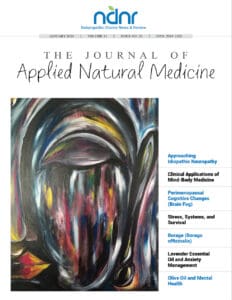Eric Yarnell, ND and Lauren Russel, ND
Crocus sativus, or saffron plant, is a domesticated herb in the family Iridaceae, the stigmata of which are known to many cooks for their vibrant color, flavor and high price. Saffron is a small, bulbous perennial, growing 6-10 inches high, with bluish-purple flowers that are lily-shaped. It is grown in countries surrounding the Mediterranean as well as in Iran, India, China, Mexico and other hot, dry climates. The spice, saffron, is prepared from the three yellow stigmata of the flowers. Just one pound of saffron requires the stigmata of more than 50,000 flowers. For the remainder of this article, “saffron” refers to the stigmata of the plant.
Among traditional and folk healers, saffron has been used as a nervine, antispasmodic, expectorant, stimulant, emmenagogue, sedative, diaphoretic, anti-inflammatory, digestive aid and antidepressant. It contains high amounts of water-soluble carotenoids and is a source of vitamin B2.
According to Weiss (2001), a tincture of saffron has also been used to treat hysteria. At one time, saffron was added to tincture of opium (Sydenham’s Laudanum) and was believed to improve opium’s action, though this has not been validated by research.
Saffron was a favorite medicine of the late Bill Mitchell, ND, who recommended drinking a tea of six stigmata daily to promote general health (Mitchell, 2003).
Saffron contains a number of active constituents. The carotenoids crocin and crocetin are largely responsible for saffron’s color. Picrocrocin gives it a hint of bitterness. The volatile oil contains safranal (Abdullaev, 2002). These constituents have been the subject of much study in recent years because of their potential in the treatment of many health conditions.
Depression
Many nervine herbs have been studied for their potential role in the treatment of depression, particularly since they are known to cause fewer side effects than antidepressant drugs. Saffron is one such herb showing promise in the treatment of patients with mild to moderate depression, based on several published clinical trials to date. One double-blind trial involved 40 people meeting the diagnostic criteria for major depression (Moshiri et al., 2006). These subjects were randomized to receive a 30mg capsule of saffron or a placebo for six weeks. Those who received saffron showed a significant improvement on the Hamilton Depression Rating Scale (HAM-D) compared to the placebo group. A similar placebo-controlled trial came to the same conclusion (Akhondzadeh et al., 2005).
The effectiveness of saffron as an antidepressant was compared to that of fluoxetine in another study of 40 adults with major depression (Akhondzadeh et al., 2007). Study participants were given either a 15mg capsule of saffron petals or a 10mg capsule of fluoxetine twice a day (morning and night) for eight weeks. At the conclusion of the study, saffron was as effective as fluoxetine for symptoms of mild to moderate depression. Similar results were seen in another trial comparing saffron to fluoxetine (Noorbala et al., 2005).
Thirty patients diagnosed with mild to moderate depression were randomized to a 30mg capsule of saffron daily or a 100mg capsule of the tricyclic antidepressant imipramine for six weeks in another double-blind trial (Akhondzadeh et al., 2004). Saffron demonstrated therapeutic results equal to imipramine, with fewer adverse effects. The mechanisms of action of saffron in people with depression have not been elucidated.
Premenstrual Syndrome
Saffron has also been the subject of study in the treatment of women with premenstrual syndrome. In one trial, 50 women with regular menses who experienced PMS were randomized to receive a 15mg capsule of saffron or a capsule containing a placebo twice a day (Agha-Hosseini et al., 2008). After four menstrual cycles, the results were assessed. Participants receiving saffron had a significant improvement in symptoms of premenstrual syndrome. Whether this improvement was due to the antidepressant effects of saffron or another effect was not determined.
Adverse Effects/Contraindications
Saffron is extremely safe, evidenced by its widespread use as a spice and lack of reports of toxicity. Its safety during pregnancy and lactation are unknown, though there is no reason to suspect problems.
Dose
To treat people with depression, saffron is commonly administered in a tincture, 2-3ml TID.
As a diaphoretic, Dr. Bastyr recommended using 10 stigmata in a cup of hot water.
Saffron is an herb with a diverse number of constituents and actions that show promise in the treatment of many health conditions. It has been overlooked in western medicine, but a growing body of evidence suggests it has significant potential.
 Eric Yarnell, ND is a graduate of Bastyr University. He completed a two-year residency with Silena Heron, ND, and served as chair of botanical medicine at SCNM. He is past senior editor of the Journal of Naturopathic Medicine. Dr. Yarnell is a founding member and current president of the Botanical Medicine Academy and author of numerous textbooks and articles, including Naturopathic Urology and Men’s Health, Naturopathic Gastroenterology and Clinical Botanical Medicine. His area of clinical focus is urology and men’s health. He is assistant professor in botanical medicine at Bastyr University.
Eric Yarnell, ND is a graduate of Bastyr University. He completed a two-year residency with Silena Heron, ND, and served as chair of botanical medicine at SCNM. He is past senior editor of the Journal of Naturopathic Medicine. Dr. Yarnell is a founding member and current president of the Botanical Medicine Academy and author of numerous textbooks and articles, including Naturopathic Urology and Men’s Health, Naturopathic Gastroenterology and Clinical Botanical Medicine. His area of clinical focus is urology and men’s health. He is assistant professor in botanical medicine at Bastyr University.
Lauren Russel, ND is a graduate of Bastyr University, currently focusing on therapies for cancer and endocrine disorders. She has been a medical writer and editor for many years, with numerous publications to her name.
References
Abdullaev F: Cancer chemopreventive and tumoricidal properties of saffron (Crocus sativus L), Exp Biol Med 227(1):20-25, 2002.
Agha-Hosseini M et al: Crocus sativus L (saffron) in the treatment of premenstrual syndrome: A double-blind, randomized and placebo-controlled trial, BJOG 115:515-9, 2008.
Akhondzadeh S et al: Comparison of Crocus sativus L. and imipramine in the treatment of mild to moderate depression: a pilot double-blind randomized trial, BMC Complement Altern Med 4:12, 2004.
Akhondzadeh S et al: Crocus sativus L. in the treatment of mild to moderate depression: a double-blind, randomized and placebo-controlled trial, Phytother Res 19(2):148-51, 2005.
Akhondzadeh BA et al: Comparison of petal of Crocus sativus L. and fluoxetine in the treatment of depressed outpatients: a pilot double-blind randomized trial, Prog Neuropsychopharmacol Biol Psychiatry 31:439-42, 2007.
Deng Y et al: Studies on the pharmacological effects of saffron (Crocus sativus L) – a review, Zhongguo Zhong Yao Za Zhi 27:565-8, 2002.
Hosseinzadeh H and Younesi HM: Antinociceptive and anti-inflammatory effects of Crocus sativus L. stigma and petal extracts in mice, BMC Pharmacology 2:7, 2002.
Maccarone R et al: Saffron supplement maintains morphology and function after exposure to damaging light in mammalian retina, Invest Ophthalmol Vis Sci 49:1254-61, 2008.
Mitchell W: Plant Medicine in Practice. St. Louis, 2003, Elsevier.
Moshiri E et al: Crocus sativus L. (petal) in the treatment of mild-to-moderate depression: a double-blind, randomized and placebo-controlled trial, Phytomedicine 13(9-10):607-11, 2006.
Noorbala AA et al: Hydro-alcoholic extract of Crocus sativus L. versus fluoxetine in the treatment of mild to moderate depression: a double-blind, randomized pilot trial, J Ethnopharmacol 97(2):281-4, 2005.
Premkumar K et al: Protective effect of saffron (Crocus sativus L) aqueous extract against genetic damage induced by anti-tumor agents in mice, Hum Exp Toxicol 25:79-84, 2006.
Weiss RF: Herbal Medicine, Classic Edition. New York, 2001, Thieme.

